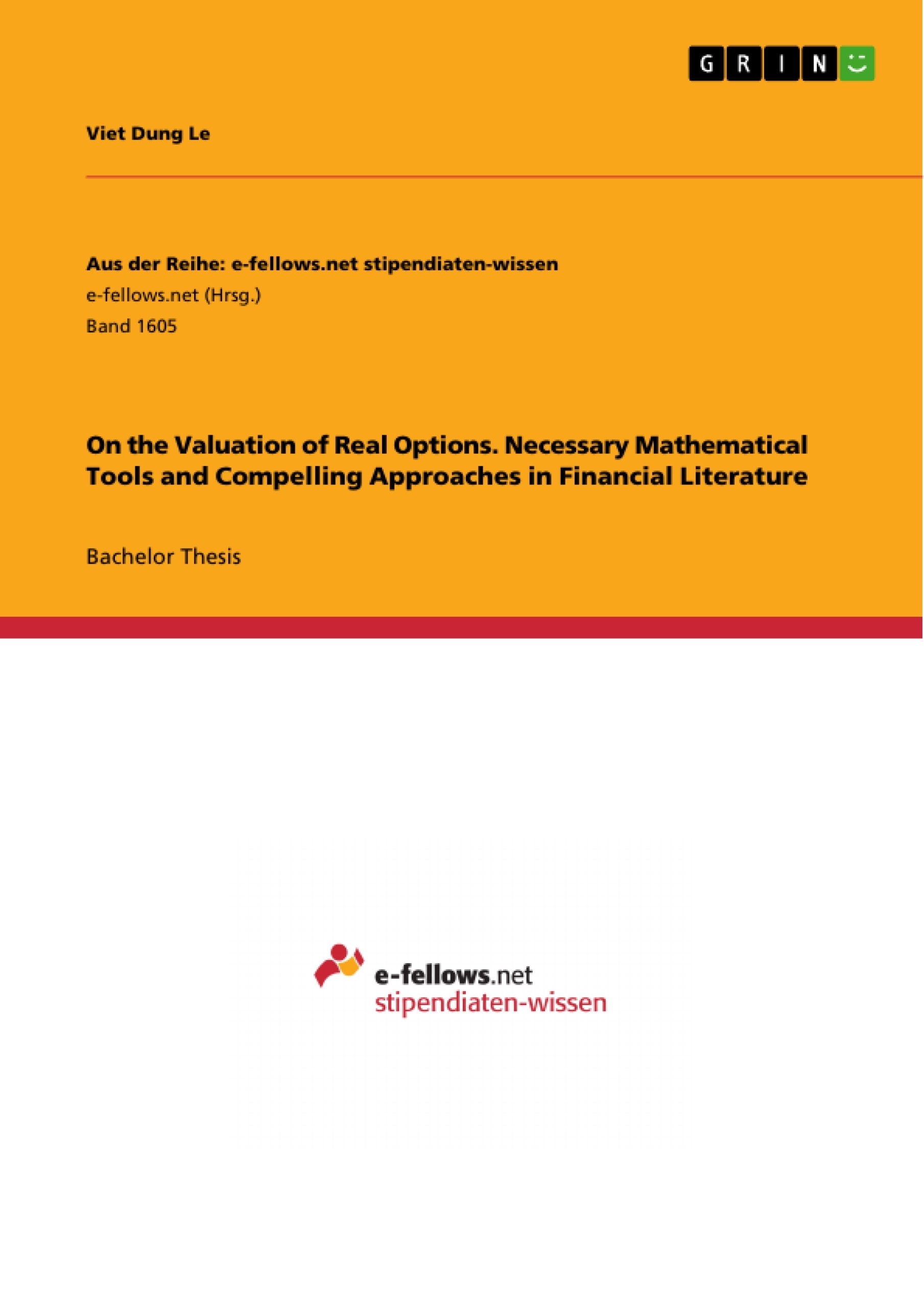When making project decisions under uncertainty, the traditional Net Present Value (NPV) method is a popular choice among practitioners which is also taught in many financial textbooks. However, there are certain issues with the traditional method that are often overseen resulting in substantial undervaluation of a particular project. Thus, the powerful tool of real option valuation was introduced to make up for this deficit.
The purpose of this paper is to show a more comprehensive method for valuing projects under uncertainty, namely real options, by explaining the necessary mathematical tools and by giving an overview of the compelling approaches in financial literature. After explaining the underlying theory and providing a valuation example, the paper will attempt to provide reasons to the limited practice of real option analysis in the industry.
Bei Projektentscheidungen unter Unsicherheit ist die traditionelle Kapitalwertmethode (NPV) unter Praktikern sehr beliebt, weshalb sie in Finanzlehrbüchern vorwiegend berücksichtigt wird. Die Probleme, in die die traditionelle Methode resultiert, werden allerdings häufig übersehen und führen zu einer substantiellen Unterbewertung des jeweiligen Projektes.
Eine umfassendere Methode zur Bewertung von Projekten unter Unsicherheit, die Real Option Analyse, soll diesem Defizit entgegenwirken. Die hierfür benötigten mathematischen Hilfsmitteln werden erläutert und es wird ein Überblick über die methodischen Ansätze aus der Finanzliteratur gegeben. Im Anschluss an die Beschreibung der zugrunde liegenden Theorie und ein Bewertungsbeispiel, werden Gründe für die eingeschränkten Anwendung der Real Options Analyse in der Privatwirtschaft aufgezeigt.
Inhaltsverzeichnis (Table of Contents)
- Introduction
- 1 What are Real Options?
- 1.1 Definition
- 1.2 Comparison to traditional Net Present Value method
- 1.3 Types of real options and analogy to financial options
- 2 Real Options Theory
- 2.1 Literature Review
- 2.2 Stochastic Processes
- 2.2.1 The Basic and the Generalized Wiener Process.
- 2.2.2 Itô Process, Geometric Brownian Motion and Itô's Lemma
- 2.2.3 Jump-Diffusion Process.
- 2.2.4 Mean-Reverting Process
- 3 Approaches to Real Option Valuation
- 3.1 Dynamic Programming.
- 3.1.1 Discrete time optimization
- 3.1.2 Optimal Stopping
- 3.1.3 Continuous Time Optimization
- 3.1.4 Value Matching and Smooth Pasting Condition
- 3.2 Contingent Claim Analysis
- 3.2.1 Replicating Portfolio
- 3.2.2 Spanning Assets.
- 3.2.3 Smooth Pasting
- 3.3 Simulation Approach
- 3.4 Comparison of the Approaches.
- 4 Valuing undeveloped petroleum reserves
- 4.1 Valuation of a developed reserve
- 4.2 Valuation of an undeveloped reserve
- 4.3 Numerical examples.
- 4.4 Final Remarks .
- Conclusion
Zielsetzung und Themenschwerpunkte (Objectives and Key Themes)
This thesis explores the concept of real option valuation as a more comprehensive method for evaluating projects under uncertainty, compared to the traditional Net Present Value (NPV) approach. It aims to provide a thorough understanding of real options by explaining the underlying mathematical tools and exploring various valuation approaches presented in financial literature. Additionally, the paper investigates the reasons for the limited adoption of real option analysis in the industry.
- Real option valuation as a method for project evaluation under uncertainty.
- Comparison of real option valuation to the traditional NPV method.
- Mathematical tools and stochastic processes used in real option valuation.
- Different approaches to real option valuation, including dynamic programming, contingent claim analysis, and simulation.
- Reasons for the limited application of real option analysis in practice.
Zusammenfassung der Kapitel (Chapter Summaries)
The introduction presents the motivation for exploring real option valuation as a more comprehensive method for evaluating projects under uncertainty. It highlights the limitations of the traditional NPV method and introduces the concept of real options as a valuable alternative.
Chapter 1 provides a definition of real options and compares them to traditional financial options. It explores the different types of real options and their analogy to financial options, illustrating the flexibility and value they offer in project decision-making.
Chapter 2 delves into the theoretical framework of real option valuation. It reviews relevant literature, introduces key concepts of stochastic processes, and discusses the applications of various stochastic models, including the Wiener process, Geometric Brownian Motion, Jump-Diffusion process, and Mean-Reverting process.
Chapter 3 explores different approaches to real option valuation, including dynamic programming, contingent claim analysis, and simulation. It examines the strengths and weaknesses of each approach and provides insights into their practical applicability.
Chapter 4 presents a case study on valuing undeveloped petroleum reserves, demonstrating the application of real option valuation in a specific industry. It explores the valuation of a developed reserve and an undeveloped reserve, providing numerical examples to illustrate the process.
Schlüsselwörter (Keywords)
Real option valuation, Net Present Value (NPV), project evaluation, uncertainty, stochastic processes, Wiener process, Geometric Brownian Motion, Jump-Diffusion process, Mean-Reverting process, dynamic programming, contingent claim analysis, simulation, petroleum reserves.
- Citar trabajo
- Viet Dung Le (Autor), 2015, On the Valuation of Real Options. Necessary Mathematical Tools and Compelling Approaches in Financial Literature, Múnich, GRIN Verlag, https://www.grin.com/document/307164



